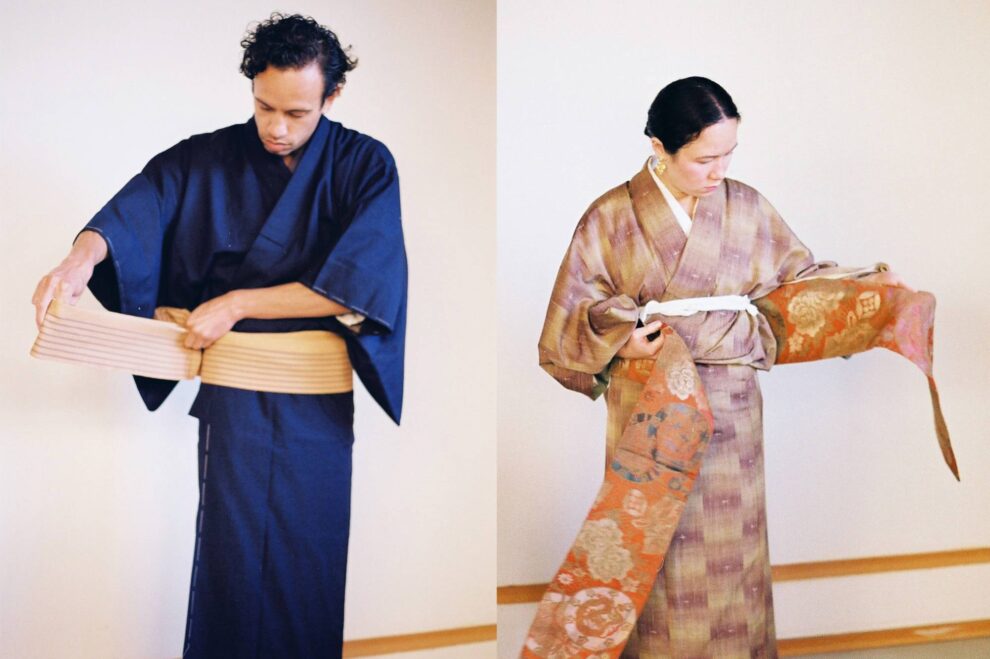Amid the chaos of the pandemic, siblings and fashion design duo Daniel and Siranee Caulfield-Sriklad relocated from London back to their hometown in County Mayo, Ireland, a place they felt gave them time and space to delve into their ancestral heritage.
Alongside COVID-19-induced upheaval, the cyclical nature and fast-paced schedule of the pair’s work in the European fashion industry left them searching for something more personal and meaningful within their careers. Their heritage, which is both Thai and Irish, had long presented Daniel, 35, and Siranee, 29, with an array of questions about belonging and identity. On one side of their family, Buddhist robes are symbolic of their father’s 30-year journey as a practicing monk. On the other branch of the family tree, Western suits are emblematic of their great-grandfather’s career as a tailor in Ireland.
“When identity lies between more than one culture, it can feel challenging to find a sense of belonging,” Siranee tells The Japan Times. “We began asking: ‘How can we use art and design to find a sense of belonging?’”
By hosting exhibitions, presentations and workshops at universities in Ireland, London and the Netherlands, the brother and sister began exploring their heritage — and encouraging others to do the same. Eventually, the duo landed on a culturally significant garment they believed could help them dive deeper into their own personal identities and where they fit in the world beyond: the kimono.
Despite having no prior connections with Japan or Japanese culture, a bit of online searching led the pair to apply for a six-week residency at Saruya Artist Residency, a joint creative’s studio and hostel in Fujiyoshida, Yamanashi Prefecture.
By living and working in rural Japan from October 2022, the Caulfield-Sriklads were able to gain first-hand insight into the intergenerational wisdom that exists in the textile trade of the region — namely by visiting factories like Watanabe Textile and Tenjin and sourcing silk from GenN Maeda & Co., Ltd.
“(Being at Saruya) provided us with this immediate, local access to a community, other creatives and local industries,” explains Daniel. “We got direct access to that knowledge and ancestral stories.”
Working with textiles also gave them an access point into the community despite not knowing the Japanese language.
“We used the language of materials and dress, simple words like ‘cotton,’ and ‘silk,’ that helped us understand and empathize with each other,” Daniel continues.
“When we arrived in Japan, it became obvious that kimonos are connected to people’s daily lives, and there is still an ongoing ritual around going out and getting dressed up in a beautiful kimono,” says Siranee. “Ancestrally, the practice, rituals and culture of the kimono is in everyone’s experience.”
One of the most important moments from the residency was an exhibition the duo hosted to showcase their finished project: two wearable kimonos as well as photographic documentation of their research and experimentation. They sourced vintage fabrics made from cotton, linen, ramie, wool and silk from Kyoto and new materials — including Cupro, a regenerated cellulose textile neither had worked with before — from manufacturers around Fujiyoshida.
In a world where foreigners are sometimes chastised for “appropriating” kimono and other garments inextricably linked to a particular culture or ethnic group, the Caulfield-Sriklads instead leaned into the argument that traditional dress can be a fruitful vessel for cultural exchange.
“It was important for us to use natural fabrics that were local to the places we visited and to honor the original patterns for the kimono,” Siranee says. “This made wearing the kimono feel very natural and accessible to those local to Fujiyoshida.”
As Fujiyoshida locals viewed up close and tried on the siblings’ handmade garments, the attendees began sharing their own personal stories and memories of wearing kimonos. Reflecting back on their original conundrum — How can we use art and design to find a sense of belonging? — it was during the exhibition when the Caulfield-Srikalds say they felt a sense of resolution and achievement.
“(The attendees) were saying, ‘Thank you so much for doing this work. It’s so beautiful,’ and that’s when we thought to ourselves: Wow, we really achieved what we wanted to,” says Daniel. “There were no mirrors in the space, so it was just about how it felt to wear the garments; it was a really beautiful exchange.”
Looking ahead, the pair may experiment with Korean hanbok or Indian saris — this time certain that art and design are worthwhile tools of cultural curiosity.
Source : Japan Times











